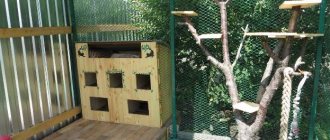- Trap tube
Some hamsters have a very restless disposition. They are restless, energetic and try to escape from their owner at the first convenient opportunity. If the hamster has escaped, you need to urgently start searching for it. After all, invisible dangers may lie in wait for the animal outside the cage. Therefore, every owner should know where a pet can hide and how to catch a hamster.
The main reasons for a hamster escaping from its cage
Rodents most often escape for the following reasons:
- Interest. Animals are primarily driven by curiosity. Not all pets are ready to look for a weak twig or open the door on their own to admire the surrounding “surroundings”. However, if the owner leaves the rodent in an open area or forgets to secure it, the animal will most likely run away.
- Poor placement of the cage. Escape may be due to the desire to find a safe or more comfortable place. For example, a hamster will try to get out of its cage if it is in the sun. Otherwise, he faces death. Loud sounds or too bright light in the room can provoke a desire to leave the house.
- Fright. Hamsters are often frightened by other animals. In most cases these are cats and dogs. The first may jump up to the cage and even try to injure the rodent. The dogs bark loudly and show interest in the hamster, which also greatly frightens the latter. The rodent will run away at the first opportunity to find a safer place.
- Boredom. Your pet may decide to entertain itself if you do not provide it with sports equipment and toys. Most often, the main target is the cell. The hamster begins to chew on parts, which leads to the possibility of escape.
- Stress. Its causes are overcrowding, pain, pathologies, etc. Even bathing can provoke stress. Under the influence of adrenaline, the desire to be in a safe place intensifies. For this reason, the hamster tries to leave the cage or breaks out of hands and runs away.
Signs of pests
The wild rodent is not frightened by the presence of people, so it calmly occupies the homestead territory and safely settles down on it. You can determine that you have country hamsters by the following signs:
- numerous minks;
- paw prints and trails on the soil surface;
- traces of gnawing on fruits and vegetables;
- the presence of underground tunnels leading to plant rhizomes;
- damage to the lower part of the bark and young shoots of vegetation.
If you find all this on your site, you need to take immediate action. Considering some of the life features of such pests, you risk losing everything you have grown on your site.
How to find an escaped hamster
If the owner discovers that his hamster has disappeared from its cage, the first thing you need to do is make sure of this and check all the accessories. Pets sometimes hide in houses, shelters and wheels, then fall asleep there. Perhaps the animal is inside the cage, but the owner does not see it.
Hamsters sometimes hide in shelters and fall asleep there.
You need to start searching from the nearby area. It is necessary to inspect the table on which the cage stands, adjacent furniture, decorative items, etc. It is advisable to find the hamster before it falls to the floor. If there is no one on the table, you need to inspect the area under it. There is a possibility that the animal fell carelessly, was injured and remains in place. Additionally, you should check the space under the closet, sofa and behind the radiators.
To protect your pet, you should close the toilet lid.
An animal may accidentally jump into it and drown. You should turn off all electrical appliances and remove deep containers with water.
Where could the animal be hiding?
Rodents like dark, narrow spaces where they can hide or crawl around in search of adventure.
The main places where a hamster can escape:
- spaces under furniture (sofas, cabinets, armchairs);
- various boxes, drawers, open shelves of cabinets;
- places with free access to treats (buckets of apples, a cupboard with sweets);
- bed linen, bedspreads, pillows.
Important! If this is not the first time your hamster has escaped from its cage, it is advisable to check the place where it could have been found before.
Precautions if there are predatory animals in the apartment
Predatory animals detect hamsters faster than their owners. This is due to their good sense of smell, hearing, sight and smell. For a rodent, such a collision could result in injury or even death. For this reason, other animals must be isolated during the search. This applies even to peaceful cats and dogs, since they may decide to play with their pet and not calculate the strength.
The interior doors are closed. At the same time, this helps prevent the rodent from unhindered movement around the house. Predatory animals are left in a room in which the hamster is definitely not present. If the owner is not sure, it is better to ask someone to look after other pets, taking them in for a while, placing them in a spacious cage or carrier, etc. Otherwise, it is impossible to guarantee the safety of the rodent.
Cats and dogs must be isolated from the premises.
It is necessary to warn all family members in advance about the loss. Otherwise, without knowing it, they may accidentally release their pet outside by opening the door, or release other isolated pets.
Search strategy
How to find a hamster in an apartment, using knowledge about some of the habits and habits of these animals? For example, it is known that hamsters are nocturnal animals, that is, at this time their activity increases. If you haven't found it before evening, don't get upset. Most likely, closer to midnight, people will start running around the apartment and then you can quickly notice the loss. But be careful with the rest of the family - don’t accidentally step on the animal.
Use a bait trap. Place a few sunflower seeds in some corners of your home - and the rodent will not keep you waiting. If you don't take him by surprise, you'll at least have a rough idea of where the pet is hiding. Of course, if the loss of seeds is not the work of hungry household members. Or you can be even more cunning - sprinkle the floor around the piles of seeds with flour or starch. Then the white footprints will lead you to the shelter of the lost homa. Another method to find it is to lay foil or other “rustling” material on the floor in the area of the intended hiding places. At night, hide nearby and listen to the surrounding sounds, trying not to make unnecessary movements.
Simple tips on how to find an escaped hamster in an apartment will help you determine its location. But the process of capture itself is also not an easy task. How can you competently deal with it?
What to do if a hamster escapes in an apartment
If your hamster escapes, the first thing you need to do is prevent it from leaving the house. The windows should be closed. If there are gaps under locked interior doors, they need to be plugged with something: a rodent can get through the gap.
First of all, you need to take safety measures. For example, remove rodent baiting agents, mousetraps and other traps from public access. Then carefully examine all the places where rodents like to hide. This applies to corners, dark and cramped areas, etc. When moving, you need to carefully look at your feet. If the color of the escaped hamster is very different from the floor covering, there should be no problems. However, if there is a partial or complete match, there is a risk of injury to the rodent.
While searching, it is recommended to remove all carpets, including small ones in front of the front door and in the bathroom. Rodents can get under them.
If a person does not notice the fugitive in a timely manner, he will step on him. Small hamsters most often do not recover from such severe injuries.
Where do rodents like to hide?
Rodents' favorite places are behind furniture. Hamsters love darkness and warmth. They can crawl into holes in walls or floors. Rodents often hide in bedding and clothing. Such places become a trap for the pet: he cannot get out. You should be careful when looking for a hamster in fabric products, since even the slightest pressure on your pet’s body can cause injury.
Rodents can hide in holes in walls.
How to properly track a hamster's location
If a visual inspection fails to detect your pet, you will have to track it by sound. Hamsters are noisy animals. They love to play with things, so they rustle. They have relatively noisy breathing. The pet makes sounds when it eats.
To determine the location of a hamster, you can use several tricks. A lost rodent is lured out with food. They pour food along the wall and wait until the pet gets hungry. Hamsters are shy animals, so they prefer not to go into the middle of the room, especially if there is someone in the room. They are more willing to eat what is along the walls. When it is discovered that some of the food has disappeared, the room will need to be closed. In the future, the search range will narrow, so catching the rodent will become easier.
Tracking down the fugitive
First of all, let's set priorities: before catching an animal, it must first be detected. Therefore, the question “how to catch an escaped hamster?” replace it with “how to track an animal?”
Methods of tracking a baby can be different. They depend on the size of the room, the number of rooms and the availability of available materials. First, let's figure out how to catch a hamster in an apartment with several rooms. You can determine the location of a rodent in different ways:
- attract food. Treats should be left in the hallway, each room and kitchen overnight, and all doors should be closed tightly. Carry out an audit the next day. Where the grains disappear (or are scattered), there the homa hides;
- listen. The hamster can gnaw grains, squeak quietly or rustle its claws on the linoleum. Hide, turn off the lights and listen. It is advisable to turn off noisy electrical appliances;
- look around. You may notice rodent feces.
When you figure out the room in which your pet is hiding, find out which side of the room he is hiding in. To do this, add the grains again, and rub a thin layer of flour around them. In the morning you will definitely see a chain of tiny footprints leading to the homa’s shelter.
How can you lure an animal out of hard-to-reach places?
In most cases, the animal's owners begin to move furniture during the search to find the fugitive. This is the wrong approach. Your pet can be accidentally injured or seriously frightened. It is better to resort to tricks, since luring a hamster out from under a closet or bed is easier than treating it in case of internal damage.
The easiest way to attract a pet is with food. However, given a choice, the animal may become more interested in the available food. For example, a bag of cereal or bread crumbs. All food must be removed from public access. Porridge and grains should be poured into glass containers.
Some pets prefer physical activity. For example, Djungarians are often attracted to wheels. Hamsters, although inquisitive, are more likely to return to something familiar than try something new. For this reason, you can try to attract them with your favorite toys.
The easiest way to lure an animal out is with food.
Put some treats
If your hamster is lost, it will soon become hungry. At this moment he needs to be offered a treat. It is better to leave food near the wall. The hamster will be more willing to take the treat from there. No need to leave a lot of food. The main task is to catch the pet, not feed it. You can place a plastic bag under the treat.
Thanks to him, you will be able to hear the animal’s steps. The treat should be crispy. This will create additional noise.
Leave your favorite thing
Hamsters love to hide and play. They need to grind their teeth down sometimes. To lure the fugitive out, you can leave a wheel, a toy, a house, etc. in the room. Twigs that the pet is used to gnawing are good.
rustling
You can try another method of catching a hamster. To do this, turn off all electrical appliances and lights in the room. Stay in the room with the rodent in the dark and do not move. Listen to the sounds the animal makes. You may need to wait a while. But eventually you will hear the rodent moving. You can, in order to attract a hamster, prepare carrot slices in advance. They should be tied to a string with a bell. When the animal starts eating the vegetable, you will hear a bell ringing.
Safe traps for catching a hamster
If the animal behaves restlessly and hides again when the owner approaches, you will have to set a trap. It should be safe and as quiet as possible so that the pet does not experience stress.
The cell itself
The best trap for a hamster is its cage. Here are the filler he is used to, his favorite toys, food, etc. There is a high probability that the tired fugitive himself will decide to exchange freedom for his home. It is better to leave the cage near the wall, as the pet may be afraid to go into the center of the room.
A hamster cage is the best trap.
A tube
Hamsters like to get into tight tubes and tunnels, so they can be lured with toys and devices like these. It is better to leave some of the usual food inside. This will increase the chances that the animal will not run outside when you approach.
Bucket
You can build a trap from a low bucket or shallow basin. To do this, put paper with slots on top, and a treat on it. The bottom is covered with something soft, but not dangerous to the animal. For example, crumpled paper towels will do. The animal, interested in the treat, will climb onto the trap and fall down. The smooth walls will not allow him to get out, so the owner will only have to transplant the fugitive into the cage.
Bottle
The bottle works the same way as the tube. However, it must have a wide enough neck, otherwise the pet may be injured. In the future, the animal is not taken out of the bottle by force, but the trap is placed in the cage or to the entrance to it so that the pet comes out on its own.
Hamsters love to crawl into tunnels.
Cardboard sleeve
A cardboard sleeve may attract your pet, but like a bottle, it won't hold you for long. For this reason, the owner will have to wait near the trap in order to catch the pet in time. Since both exits are open and the animal will have a good view, there is a high probability that the pet will have time to escape.
Why you should fight rodents
A wild hamster in the country can cause significant damage to the crop. That is why many gardeners, after the first signs of pests appearing, take active measures to combat them. First of all, the soil of the site suffers. Hamsters dig numerous passages and holes. One hole can reach 10 m, and its depth - up to 2 m. All these voids make it difficult to grow various crops.
Other reasons for fighting field hamsters include the following:
- Being in constant search for food, hamsters greatly damage trees, shrubs and vegetable crops. They peel off the bark and damage the lower branches of shrubs.
- Despite the fact that hamsters prefer to live alone, they willingly bring their relatives to the fertile area they find.
- Rodent fertility poses a particular risk to farmers. The female's pregnancy lasts only 16 days. During one pregnancy, she gives birth to from 5 to 18-20 cubs. Not all of them, of course, survive, but in any case, from spring to October, the female gives birth to about 100 individuals. After just 2 months, newly hatched females can produce their own offspring. Such a threatening ability to produce offspring is dangerous for the crop, since the grown young animals begin to sharpen their teeth on the bark of trees and plants and look for food for themselves.
- Hamsters have many methods of self-defense. They try not to enter dangerous areas, ignore baits placed by humans, and also create a large number of false passages to unused holes.
Symptoms
When living in an area where infection occurs in animals, it is better to arm yourself with knowledge by studying the symptoms of rabies in hamsters.
You need to monitor your pet to see if its behavior has changed. But rabies manifests itself not only in the form of aggression. For example, foxes stop being afraid of people, become docile, and can lick hands. Hamsters appear lost in space and run around the cage aimlessly. Appetite changes: disappears or increases. One of the signs may be strange sounds or squeaking. The main symptom is aggression.
Shortly before death, paralysis of the pharynx appears. The hamster can neither drink nor eat. He secretes a huge amount of saliva. His nose is always very wet. Convulsions or falling into a coma may occur before cardiac arrest.
If signs are detected, you should contact your veterinarian. The hamster will have to be put to sleep, but it will not suffer from suffocation.
The symptoms may not be very obvious and are difficult to notice. Owners often say that the hamster died unexpectedly. The rodent dies about a week after infection.
Useful tips
To make the search for the fugitive successful, follow simple rules:
- If there are other pets living in the apartment, move them away from the place where the hamster is supposed to be.
- When using mousetraps, be sure to remove them so that the animal does not get caught in them.
- Once you find an animal, limit its movement around the apartment. To do this, close all exits from the room.
- To avoid scaring the tiny creature, do not make loud or harsh sounds.
- Quite rarely, a hamster can be found in the folds of clothes, towels or bed linen - he climbs there to keep warm.
Check the cage regularly to eliminate defects in a timely manner, and ensure that the door is closed tightly. Make sure your pet is comfortable in his house and there are no irritating factors nearby. Give the animal more time and buy toys if necessary. The best way to catch a hamster is to prevent it from escaping.
Secrets of preparing bait
Bait for rodents Whatever homemade mousetraps are made, the main thing in them is the optimal choice of bait, thanks to which the mouse will want to climb there. Despite the famous children's fairy tales in which cheese is the main delicacy for mice, this is not entirely true. Mice do not eat cheese with the same pleasure as bulk products with a strong odor:
- sunflower seeds;
- bread crusts soaked in vegetable oil;
- croutons with sesame oil;
- pieces of fried lard or sausage;
- buckwheat, rice or wheat;
- nuts;
- fresh meat.
On a note!
When installing traps, it is important to provide optimal ways to approach them so that a mouse in an apartment or house can easily reach and get into the prepared device.
Warnings
- If your hamster moves only on his own, provide him with a container or his walking ball so he can climb inside and you can move him into the cage. Don't grab the hamster. If he is injured, then you can make the situation worse by grabbing the animal. Bring the hamster's walking ball to the cage door and let him move into the cage on his own.
- Be aware that your hamster can be injured (as these animals have very fragile, brittle bones) if it falls from a height of more than 25 cm.
- If your hamster falls from a great height, do not try to pick it up. If the hamster does not move but is breathing, slip a piece of paper under it and place it in the cage. If you are concerned about your hamster's condition, take him to the vet.
Feed
So how to catch a hamster in the house? If you don’t know which room the rodent is in, then pour a handful of grain into each room and leave it overnight. Place food near baseboards. The rodent will most likely find it there.
Once you have figured out where the hamster is, sprinkle handfuls of food throughout the area. This way you can understand in which part of the room the hamster lives. Thanks to this, you will be able to significantly reduce the search area.
Once you have determined which room the hamster is in, it is advisable that no one else enters it until you catch the rodent. Otherwise, there is a risk that someone will accidentally injure or step on the animal.
Expulsion method
There are several ways to get rid of hamsters in the country by expelling them:
- The method of flooding burrows is used if all branches extending from the main burrow are blocked. High pressure water is supplied continuously until the animals appear on the surface of the soil.
- Digging holes. This is a labor-intensive method that will require not only physical effort from you, but also patience. Its effectiveness increases if the dug hamster holes are treated with a special pesticide.
- To remove hamsters from your property, you can use another method - expulsion using carbide and smoke bombs. The checkers are placed as deep as possible in the holes and left there for several hours. If you use carbide, you need to take a little substance, put it in a hole and sprinkle it with moistened soil. When exposed to moisture, the toxic substance releases a specific odor. It spreads throughout the hole and thus smokes out the hamster.
- Mouse cats or dogs trained to catch rodents will help catch rodents. But there is one unpleasant moment in this fight - sometimes the pest wins in such a fight.
- An ultrasonic repeller is an effective way to combat wild hamsters in the garden. The device is tuned to a specific frequency. Ultrasonic waves negatively affect the hearing system of rodents, and they are simply forced to crawl out. Such devices operate both on batteries and from the mains. The range is more than eight meters.
Features of catching a hamster in nature
Catching a hamster at home is not too difficult a task. What to do if the animal runs away into the street?
You can use the traps described above: they do not injure the animals. However, when placing such devices in nature, you risk catching not your pet, but some wild rodent, so be careful that the living creature does not bite you.
If there are burrows of other animals near your home, the hamster probably climbed into one of them. Try to flood them. Fleeing from the water, the hamster will get out into the street, where you will catch it.











